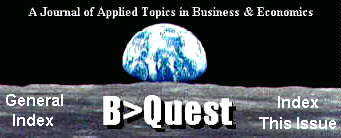|
|
|
June 30, 2004 |
|
|
|
June 30, 2004 |
In a video presentation to a London banking audience
two weeks ago, Federal Reserve Chairman Alan Greenspan stated that the
Federal Reserve would be ready to move more rapidly if inflation began to
surface. He then outlined the
areas of concern, from commodity markets, to the seepage of oil prices into
everyday costs, and the rise in labor costs per unit of production that
would suggest inflation is bubbling.
A week later, in his confirmation hearing for another
term at the Fed, Greenspan said that inflation was not now a concern of the
Federal Reserve and that interest rate increases would be measured.
This week, the Federal Reserve is meeting to determine
what policy changes are needed. At
the conclusion on Wednesday, investors are prepared for a quarter point
increase in the federal funds target used by the Federal Reserve to aid
monetary policy.
Is there inflation, is inflation not a concern, and why
would the Fed raise interest rates anyway?
The last question is the easiest to answer.
Since 2001, the Federal Reserve has encouraged unusually low short
term interest rates to jump start a weak economy.
This is appropriate policy for a weak economy.
Assuming GDP estimates of more than 5 percent gains
surface for the spring quarter, economic growth will be nearly 6 percent for
the past year. Job growth is
more than a million over that period and appears to be accelerating to more
than 200,000 new jobs per month.
In short, the reason for unusually low short term
interest rates no longer exists. Thus,
raising rates to a more normal range (about 1-1.5 percentage points below
the 4.75 percent for ten year government notes) is justified even if no
early signs of resurging inflation are apparent.
Now letís move to the more difficult question of what
is happening to inflation.
Last August, my leading inflation indicators began to
tingle. By Christmas, they were
jumping up sharply. Thus, talk
about deflation at that time was behind reality.
Pricing power was returning to corporate America.
(At a minimum, corporations were able to retain more of the cost
reductions for themselves.)
Some of my key leading inflation indicators are: the
value of the dollar against major trading partners, prices of sensitive
crude industrial commodities, labor costs per unit of production in
manufacturing, the level of capacity utilization for American industry, and
the rate of change of that utilization.
Some secondary measures are inventory changes relative to sales, and
prices of services, and the persistence of price changes for volatile
commodities such as oil and farm prices.
Except for labor costs per unit of production and
capacity utilization, all my indicators were definitely pointing toward
higher inflation ahead. However,
too many analysts, including the Federal Reserve, rely too much upon these
exceptions and not enough upon the other inflation indicators.
As measured by price changes from the previous year,
inflation for consumers rose from a low of 1.1 percent in December to its
current level of 1.7 percent in May. Even
Greenspanís favorite measure of the price deflator for consumer
expenditures other than food and energy increased from its December low of
0.8 percent to a current 1.4 percent.
These are not disturbingly high price changes, but they
certainly indicate that something has happened to inflation in the past six
months, as my indicators had forewarned.
Will this trend of accelerating prices continue?
A quick look at the producer price index by stage of
processing suggests that further price jumps are ahead.
Since the beginning of the year, intermediate prices for all those
materials used to build, package,
and transform products have been growing at more than 0.6 percent per month.
The most recent gains in April and May have been 1.1 percent and 0.9
percent respectively.
However, the sensitive price changes have turned
negative in the past two months. Commodity
inflation has stalling, even for the food and energy prices that have surged
in the past year. The dollar
also appears to have found a narrow trading range following a year of
plunging values.
My inflation indicators still are positive, but they
are slowing rapidly. This
suggests that inflation probably will rise to slightly more than 2 percent,
using the measures cited above, and then stabilize.
No, the Fed does not need to fight intensifying inflation at this time, but it must hurry to take the stimulus out of the system. Otherwise, intensifying inflation could reappear before short term interest rates return to normal.
